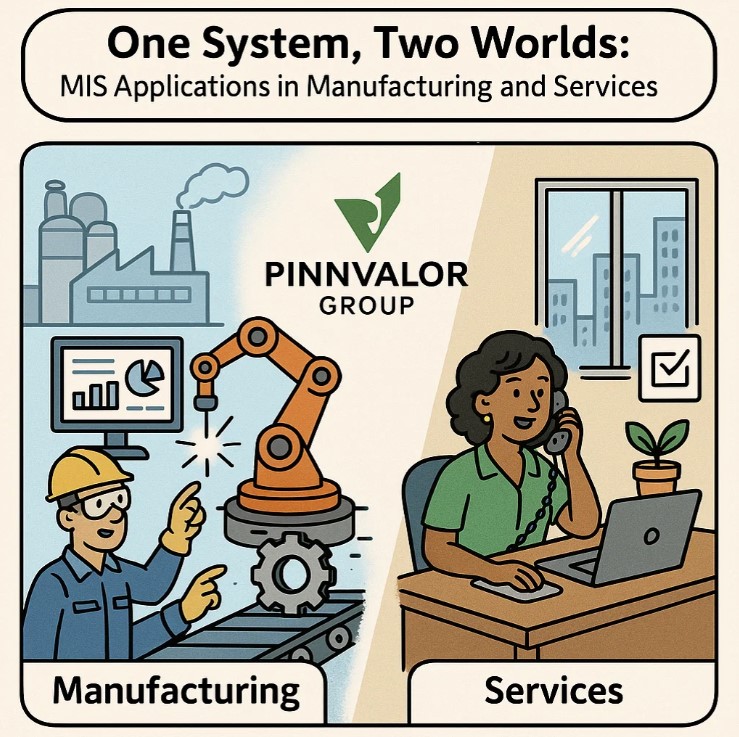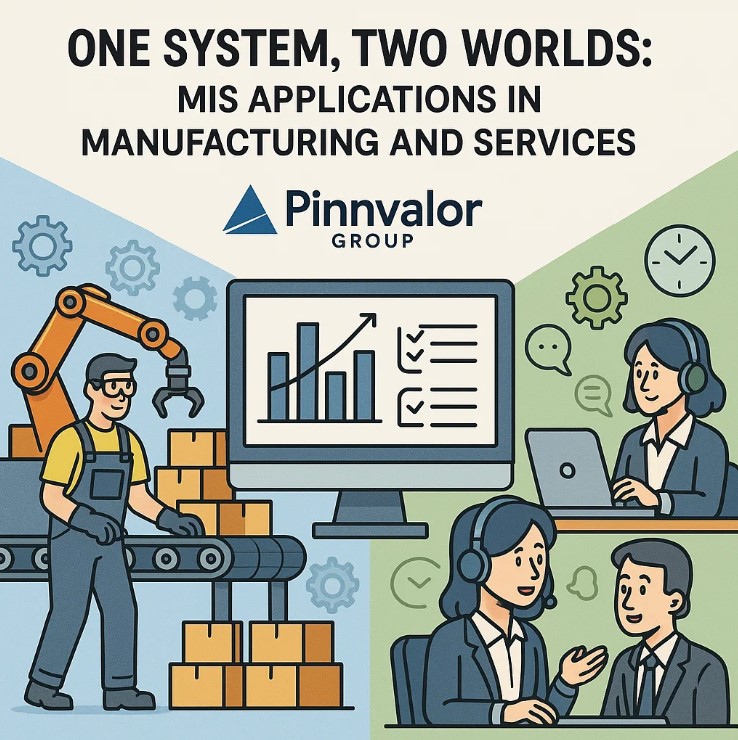
One System, Two Worlds: MIS Applications in Manufacturing and Services
Management Information Systems (MIS) play a pivotal role in driving efficiency, decision-making, and competitive advantage in organizations. However, while the core principle of MIS—collecting, processing, and delivering information to support management—remains consistent, its application in the manufacturing industry vastly differs from that in the service sector. This divergence arises from the unique operational, strategic, and customer engagement challenges each sector faces.
What role does MIS play in aligning operational workflows with industry-specific demands?
Understanding the distinct needs of manufacturing and service sectors is key to harnessing MIS’s full potential. One system, two worlds — tailored intelligence that fuels growth and innovation
In this blog, we explore how MIS frameworks are tailored to meet the distinct needs of manufacturing and service industries, highlighting the nuances and benefits that shape their respective business landscapes.
Understanding MIS: A Quick Recap
At its core, MIS integrates technology, people, and processes to provide timely, relevant, and accurate information to managers for effective decision-making. The system encompasses data collection from various business operations, transforming it into insightful reports and analytics that guide planning, control, and operational activities.
MIS in Manufacturing: Precision, Production, and Process Control
Key Focus Areas
- Inventory and Supply Chain Management: MIS in manufacturing heavily revolves around optimizing inventory levels, supplier coordination, and logistics to ensure a smooth flow of raw materials and finished goods.
- Production Planning and Scheduling: Systems facilitate detailed production schedules, resource allocation, and capacity planning, ensuring maximum efficiency and minimal downtime.
- Quality Control and Compliance: Tracking defect rates, process variations, and adherence to regulatory standards is critical. MIS provides real-time monitoring and reporting tools.
- Cost Management: Manufacturing MIS systems analyze direct and indirect costs, helping in budgeting and cost control through variance analysis.
Typical MIS Modules in Manufacturing
- Enterprise Resource Planning (ERP)
- Manufacturing Execution Systems (MES)
- Supply Chain Management (SCM)
- Quality Management Systems (QMS)
Benefits
- Enhanced operational efficiency through automation
- Real-time visibility of production and inventory status
- Improved decision-making with data-driven insights
- Reduction in waste and downtime

MIS in Service Industry: Customer-Centric and Agile
Key Focus Areas
- Customer Relationship Management (CRM): MIS in services focuses on managing interactions with clients, tracking service delivery, feedback, and enhancing customer satisfaction.
- Human Resource and Workforce Management: Service industries rely heavily on skilled labor and scheduling flexibility, making workforce management systems essential.
- Service Delivery and Performance Monitoring: MIS tracks key performance indicators (KPIs) such as service turnaround times, resolution rates, and client retention.
- Billing and Financial Management: Efficient billing systems integrated within MIS ensure accurate invoicing and revenue tracking.
Typical MIS Modules in Services
- CRM Systems
- Workforce Management Software
- Service Level Management Tools
- Financial and Billing Systems
Benefits
- Personalized customer experiences through data analytics
- Greater flexibility and responsiveness to client needs
- Enhanced employee productivity and scheduling
- Streamlined billing and revenue assurance
Contrasting Challenges and MIS Adaptations
| Aspect | Manufacturing MIS | Service Industry MIS |
|---|---|---|
| Nature of Output | Tangible products | Intangible services |
| Process Orientation | Process-driven, repetitive workflows | People-driven, variable workflows |
| Inventory Focus | Raw materials and finished goods stocks | Minimal physical inventory |
| Customer Interaction | Often indirect, through distributors | Direct and continuous client engagement |
| Data Emphasis | Production, quality, and cost data | Customer data, service quality metrics |
The Converging Future: MIS Integration Across Industries
With digital transformation accelerating, both manufacturing and service sectors increasingly adopt integrated MIS platforms blending ERP, CRM, IoT, and AI-driven analytics. This convergence allows manufacturing companies to improve after-sales service and customer engagement, while service industries leverage automation to streamline back-office operations.
Conclusion
While the essence of Management Information Systems remains universal, their deployment in manufacturing and service industries reflects fundamentally different operational realities and business priorities. Understanding these distinctions helps organizations design and implement MIS solutions that not only streamline operations but also create strategic value aligned with their industry demands.
